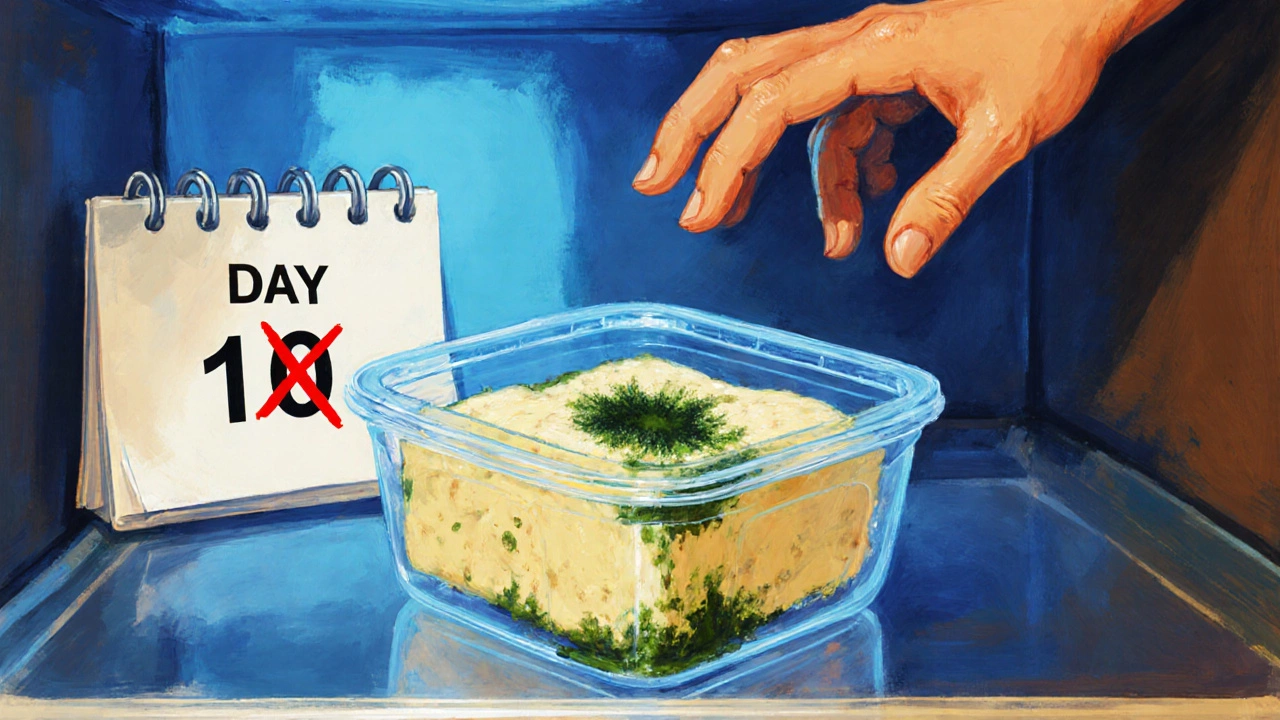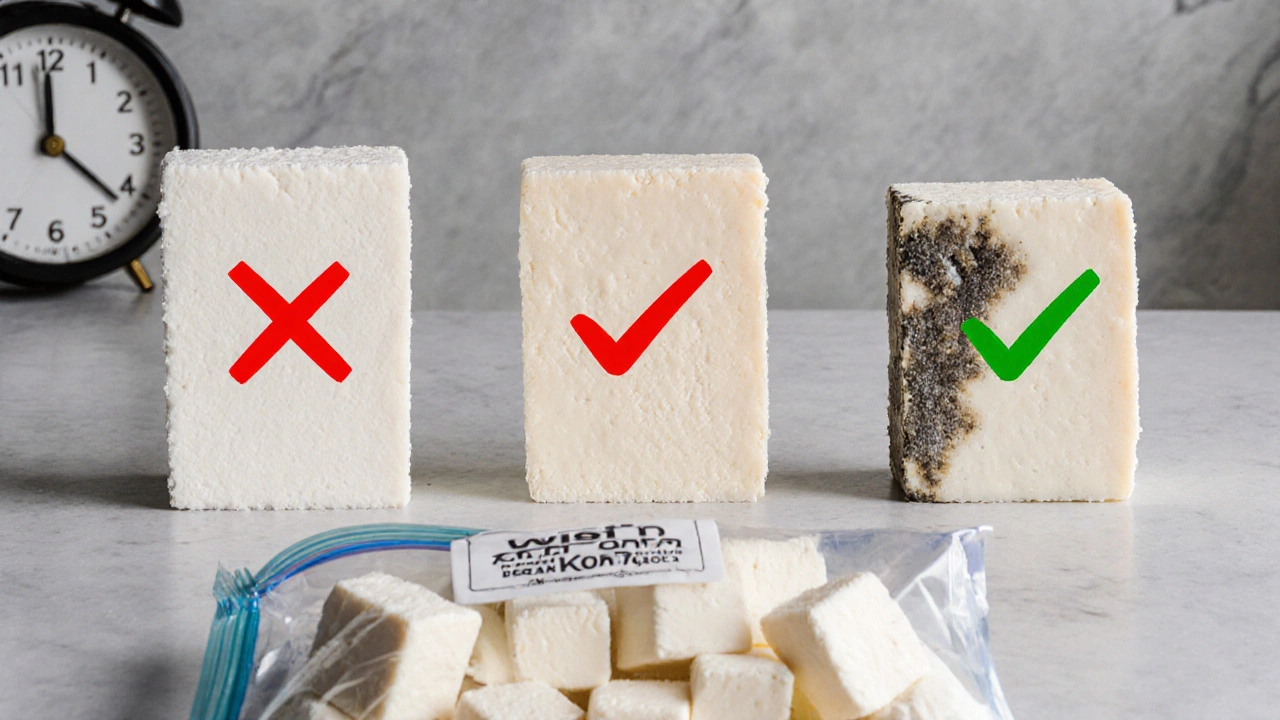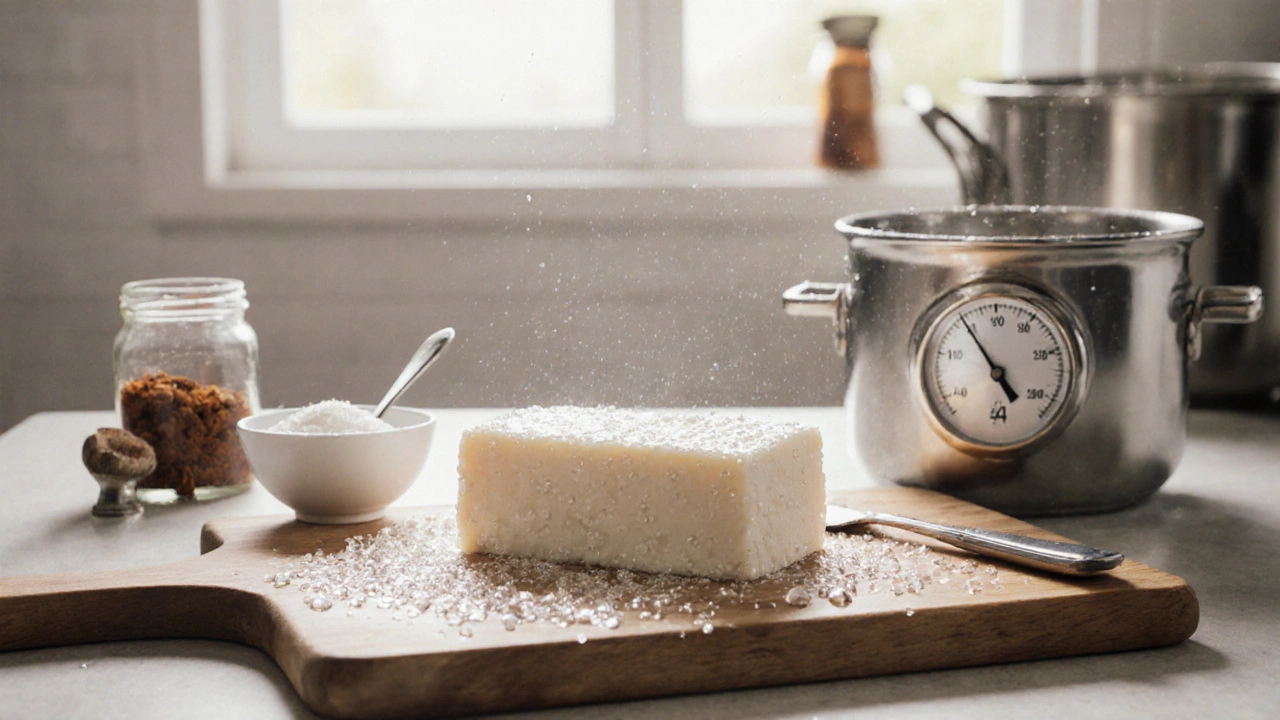Paneer Safety Checker
Check Paneer Safety
You made fresh paneer last week-soft, creamy, and perfect for your butter paneer curry. Now it’s day 10. You open the fridge, and it still looks fine. No mold, no weird smell. But you pause. Can we eat 10 days old paneer? The answer isn’t yes or no. It’s about what you’re really seeing-and what you’re risking.
Paneer doesn’t last like cheese
Paneer is not cheddar. It’s not feta. It’s fresh, unaged, and made without preservatives. Unlike hard cheeses that can sit for months, paneer is basically cooked milk curds pressed into a block. That means it’s high in moisture, low in salt, and packed with proteins that bacteria love. In a fridge at 4°C (39°F), paneer typically lasts 5 to 7 days max. After that, it’s not just getting stale-it’s becoming a breeding ground.
Home refrigerators aren’t lab-controlled. Door openings, temperature spikes, and cross-contamination from raw meat or veggies make things worse. A study by the Indian Council of Medical Research found that homemade paneer stored in non-airtight containers showed visible bacterial growth by day 6, even when refrigerated. That’s not speculation. That’s lab data.
What does spoiled paneer look and smell like?
Here’s what to check before you bite into that 10-day-old block:
- Smell: Fresh paneer has a clean, milky scent. Spoiled paneer smells sour, like old yogurt left too long-or worse, like wet cardboard or ammonia. If it makes you wrinkle your nose, don’t risk it.
- Texture: It should be firm and slightly springy. If it’s slimy, sticky, or falls apart when you press it, bacteria are already breaking it down.
- Color: White or off-white is normal. Yellowish tinges, greenish spots, or fuzzy patches mean mold. Even one tiny spot means the whole block is contaminated. Mold spores spread fast in moist foods.
- Taste: Never taste it to check. One bite of spoiled paneer can give you food poisoning-nausea, vomiting, diarrhea, fever. It’s not worth the gamble.
Some people say, “I’ve eaten 10-day-old paneer before and felt fine.” That’s luck, not safety. Food poisoning doesn’t always hit right away. Sometimes it’s delayed. Sometimes it’s mild. But sometimes it’s not. And with kids, elderly, or pregnant people in the house, the risk isn’t worth it.
Why 10 days is a hard line
Let’s say you stored your paneer perfectly-in an airtight container, submerged in cold water, changed daily. Even then, 10 days is too far.
Here’s why: Listeria monocytogenes can grow in refrigerators. It doesn’t need warmth. It thrives at 4°C. And paneer? It’s the perfect host. Unlike meat or dairy products that are pasteurized or aged, paneer is raw milk curdled and pressed. No kill step after that. No chemical inhibitors. Just milk, acid, and time.
The FDA and Food Safety and Standards Authority of India (FSSAI) both recommend consuming fresh paneer within 3-5 days. Even the most careful home cooks don’t beat those guidelines. If you’re stretching it to 10 days, you’re not being clever-you’re playing Russian roulette with your gut.

What to do instead
Don’t throw it out just yet. Here’s how to save your paneer before it turns risky:
- Freeze it: Cut paneer into cubes, lay them on a tray, freeze for 2 hours, then bag them. Frozen paneer lasts up to 6 months. Thaw in the fridge overnight. Texture changes slightly-less springy, more crumbly-but it’s perfect for curries.
- Use it early: If your paneer is 5 days old and still good, make a quick dish. Paneer bhurji, paneer tikka, or even just sauté it with garlic and cumin. Heat kills surface bacteria. Don’t eat it raw.
- Make paneer again: If you’re making paneer weekly, keep a small batch of fresh milk on hand. It takes 15 minutes to make a new block. No need to risk old ones.
There’s no shame in making fresh paneer every week. It’s cheap, easy, and tastes better. You don’t need to store it for days. You need to use it while it’s good.
Storage myths that get people sick
Let’s clear up some dangerous ideas:
- Myth: “Submerging paneer in water keeps it fresh for weeks.” Truth: Water slows drying but doesn’t stop bacteria. Change water daily, or it turns into a bacterial soup.
- Myth: “If it smells okay, it’s fine.” Truth: Many harmful bacteria don’t change smell until it’s too late. Listeria? Odorless. Salmonella? Often smell-free.
- Myth: “I’ll cook it well, so it’s safe.” Truth: Cooking kills surface germs but not the toxins some bacteria leave behind. Staphylococcus aureus produces heat-stable toxins. Once made, you can’t cook them away.
Food safety isn’t about appearances. It’s about time, temperature, and hygiene. Paneer is too perishable to treat like pantry staples.

Real-life example: What happened in my kitchen
Last year, I made a big batch of paneer for a party. I stored it in a sealed container in the fridge. By day 8, it looked fine. I used it in a curry. My 7-year-old ate it. Two hours later, she vomited. No fever. No hospital. But she was miserable for 12 hours. I threw out the rest. I didn’t make paneer again for a month. I learned the hard way: freshness isn’t optional. It’s the rule.
That’s not a scare story. That’s a real consequence. And it happened because I thought, “It still looks okay.”
Final verdict: Should you eat 10-day-old paneer?
No.
Not because it’s impossible. Not because you’ll definitely get sick. But because there’s zero benefit and real risk. You’re trading a $2 block of paneer for a day of illness, a trip to the doctor, or worse. Fresh paneer takes minutes to make. Freezing is free. Why gamble?
Next time you’re tempted to eat old paneer, ask yourself: Is this worth it? The answer’s always the same. Make fresh. Freeze extra. Toss what’s past its prime. Your stomach will thank you.
Can you eat paneer after 7 days?
Technically, if stored perfectly-in an airtight container, submerged in cold water changed daily, and kept at 4°C or below-paneer might be safe up to 7 days. But it’s risky. By day 5, quality drops. By day 7, bacterial growth becomes likely. For safety, aim to use it within 5 days. If you need to keep it longer, freeze it.
How do you know if paneer has gone bad?
Check for three signs: smell, texture, and appearance. Spoiled paneer smells sour or ammonia-like, feels slimy or sticky, and may show yellow, green, or fuzzy spots. If any of these are present, throw it out. Even one spot of mold means the whole block is contaminated. Never taste it to check.
Does freezing paneer ruin its texture?
Freezing changes paneer slightly-it becomes a bit crumbly and less springy. But it’s still perfect for cooking. Frozen paneer works great in curries, stir-fries, and grilled dishes. Just thaw it in the fridge overnight. Don’t use it raw after freezing, like in salads. The texture loss doesn’t matter when it’s cooked.
Can you reheat paneer to make old paneer safe?
Heating paneer kills surface bacteria, but it doesn’t destroy toxins already produced by harmful microbes. Bacteria like Staphylococcus aureus make heat-resistant poisons. If the paneer is already spoiled, cooking won’t fix it. Always rely on smell and appearance-not heat-to judge safety.
Is store-bought paneer safer than homemade?
Sometimes, but not always. Store-bought paneer may have preservatives or be pasteurized, which gives it a longer shelf life-usually up to 10-14 days unopened. But once opened, treat it like homemade: use within 3-5 days. Always check the expiration date and smell before using. Don’t assume packaging means safety.
What’s the best way to store homemade paneer?
Keep paneer in an airtight container, submerged in cold, clean water. Change the water every day. Store it in the coldest part of the fridge-not the door. For longer storage, freeze it in portions. Never leave paneer at room temperature for more than 2 hours. Moisture and warmth are its worst enemies.
